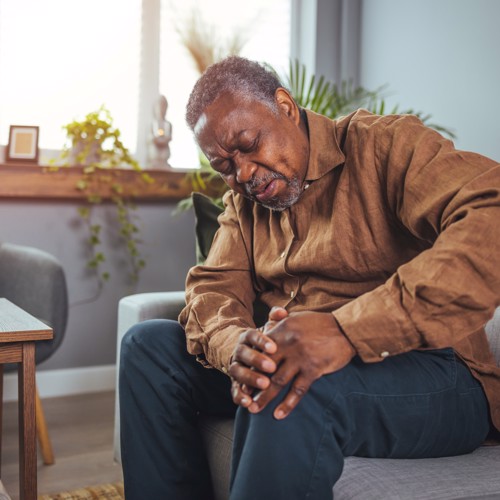Oxford Score 0 – Clinical Judgement 1
NO
PHARMACEUTICAL INFLUENCE
Oxford Score 0 – Clinical Judgement 1

An ill-timed jump for a header, an awkward landing, a disturbing pop in my knee and the worst pain I’ve ever felt. Thus went my left anterior cruciate ligament and with it my fantasy of tearing up the left wing for my beloved Sheffield United.
Roll on 30 years and that same knee’s steady deterioration has reached a tipping point. Previously intermittent pain has become constant, and a varus deformity has developed that rivals that of a 90-year-old neighbour who walks his dog with TWO walking sticks. I’ve ruminated on the need to do something about this situation but have been deterred by an Oxford Knee Score well above that required under the local referral pathway for knee replacement.
It was with some interest that I read in the recently published NICE Guidance on Osteoarthritis and that we should “use clinical assessment when deciding to refer someone for joint replacement instead of systems that numerically score severity of disease.” This is not just for selfish reasons. I’ve long felt imposing a scoring system on our patients to allow them to qualify for a knee replacement was unfair. An objective scale it is not. Take question 1 – “How would you describe the pain you usually have in your knee?” I’m guessing my take on “severe” may differ significantly from that of Bear Grylls and that’s not taking into account the effect of psycho-social factors on patients’ perception of pain. NICE stated pretty much the same in the previous guideline, but perhaps with this update, we might see local referral protocols catch up.
Of course, with ever-stretching waiting lists, getting a referral for a knee replacement is only the beginning of a drawn-out process. Do the guidelines offer anything that can help our patients (and me) in the meantime? Firstly, we should be making the diagnosis of OA in anyone over 45 with activity-related joint pain without prolonged morning stiffness. X-rays are not indicated routinely and should only be ordered if there are atypical features or the possibility of an alternative diagnosis.
The core treatments for OA remain as therapeutic exercise and weight management (if appropriate), along with information and support. Doing regular and consistent exercise is beneficial for joints even if it makes things more painful at first. Sticking to an exercise plan long-term increases its benefit – reducing pain and increasing quality of life. Exercise should be tailored to the patient and NICE say we should consider a treatment package (a more holistic approach), although this will, of course, depend on local provision. Weight loss will help those patients with OA who also have obesity and overweight, but as attendees at our Managing Obesity course will know, this is easier said than done and discussions around this need to be handled sensitively. A patient’s BMI should not be a barrier to referral for an orthopaedic opinion if conservative measures fail.
NICE does offer further guidance on the use of acupuncture (no), steroid injections (sometimes) and walking sticks (my neighbour has it right), but the main take-home point for me is in the pharmacological management section. NICE now state that we should “offer” (their strongest recommendation) topical NSAIDs to people with knee OA with the less strong “consider” for other affected joints. We should not routinely offer paracetamol or weak opioids and the risks of strong opioids are considered to outweigh the benefits. All these recommendations are changes from the last guideline published back in 2014 and certainly something to think about as I rub in some ibuprofen gel, catch up on the football and dream about what might have been.
Dr Andy Ward
12th January 2023
Join us at one of our upcoming courses or live webinars

Recent NB Blogs
Need an immediate update? – all our courses are available on demand
Did you find this useful?
You can quickly add CPD to your account by writing a reflective note about the Oxford Score 0 – Clinical Judgement 1 post you've read.
Log in to your NB Dashboard and use the 'Add Reflective Note' button at the bottom of a blog entry to add your note.

